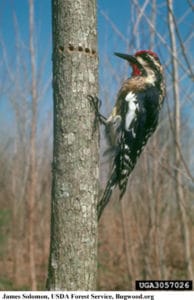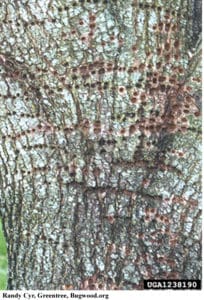 The yellow-bellied sapsucker is a type of woodpecker that primarily feeds on sap but also eats the insects attracted to sap. Sapsuckers attack live trees, and often return to the same tree to increase the size of the original holes for fresh sap. Insects, rodents, and pathogens are attracted to the weakened tree and can cause additional injury. With repeated attacks, the tree can be killed.
According to a study by the United States Forest Service sapsuckers kill nearly 40% of the red maples they attack, but only 1% of the hemlocks. Other favorite trees of the sapsucker are the pecan, holly, birch, pine, elm and some oaks.
Maple trees attacked by sapsuckers will often develop a black stained trunk over time. This is due to a fungus that develops on the excrement of the insects that have been drawn to the tree by the readily available sap. The black stain is not detrimental to the tree but isn’t aesthetically pleasing either.
Sapsucker damage is easy to identify. Puncture wounds (one eighth of an inch in diameter) and the resulting sap flow are the most obvious symptoms. The holes are neatly spaced in horizontal and vertical rows around the trunk of the tree. Sapsuckers have long, brush-tipped tongues that can remove the sap from the holes they create.
The yellow-bellied sapsucker is a type of woodpecker that primarily feeds on sap but also eats the insects attracted to sap. Sapsuckers attack live trees, and often return to the same tree to increase the size of the original holes for fresh sap. Insects, rodents, and pathogens are attracted to the weakened tree and can cause additional injury. With repeated attacks, the tree can be killed.
According to a study by the United States Forest Service sapsuckers kill nearly 40% of the red maples they attack, but only 1% of the hemlocks. Other favorite trees of the sapsucker are the pecan, holly, birch, pine, elm and some oaks.
Maple trees attacked by sapsuckers will often develop a black stained trunk over time. This is due to a fungus that develops on the excrement of the insects that have been drawn to the tree by the readily available sap. The black stain is not detrimental to the tree but isn’t aesthetically pleasing either.
Sapsucker damage is easy to identify. Puncture wounds (one eighth of an inch in diameter) and the resulting sap flow are the most obvious symptoms. The holes are neatly spaced in horizontal and vertical rows around the trunk of the tree. Sapsuckers have long, brush-tipped tongues that can remove the sap from the holes they create.
 Besides the round holes created for sap, the sapsuckers will create shallow, rectangular holes which they maintain continually for the sap to flow freely and attract insects. Sapsucker damage is sometimes confused with borer damage. Borers usually leave sawdust, whereas sapsuckers do not. Borer holes are rarely as numerous as sapsucker holes and are placed randomly, not in rows. Woodpeckers are generally much less damaging to trees. They tend to feed and nest in dead wood, therefore doing no damage to living trees.
Thank you for reviewing this information. Schneider Tree Care is committed to preserving and enhancing the quality of your property through tree care education and services. We employ professionally trained and certified arborists who are available to meet with you for a consultation at no charge.
If you have any questions or need additional information regarding the health of your trees, please contact us.
Besides the round holes created for sap, the sapsuckers will create shallow, rectangular holes which they maintain continually for the sap to flow freely and attract insects. Sapsucker damage is sometimes confused with borer damage. Borers usually leave sawdust, whereas sapsuckers do not. Borer holes are rarely as numerous as sapsucker holes and are placed randomly, not in rows. Woodpeckers are generally much less damaging to trees. They tend to feed and nest in dead wood, therefore doing no damage to living trees.
Thank you for reviewing this information. Schneider Tree Care is committed to preserving and enhancing the quality of your property through tree care education and services. We employ professionally trained and certified arborists who are available to meet with you for a consultation at no charge.
If you have any questions or need additional information regarding the health of your trees, please contact us. 









